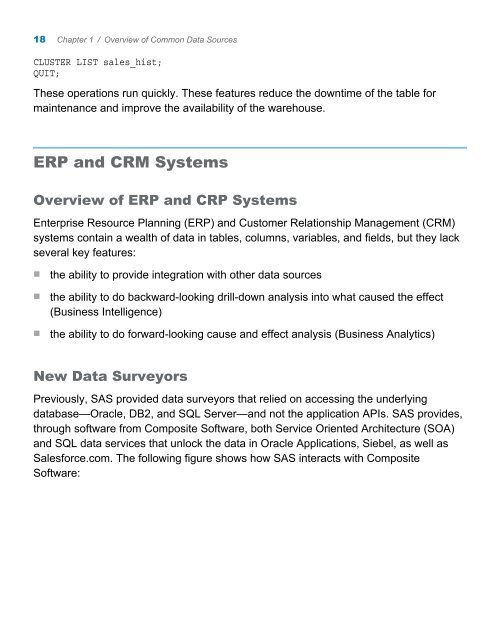SAS 9.3 Intelligence Platform: Data Administration Guide, Second ...
SAS 9.3 Intelligence Platform: Data Administration Guide, Second ...
SAS 9.3 Intelligence Platform: Data Administration Guide, Second ...
Create successful ePaper yourself
Turn your PDF publications into a flip-book with our unique Google optimized e-Paper software.
18 Chapter 1 / Overview of Common <strong>Data</strong> Sources<br />
CLUSTER LIST sales_hist;<br />
QUIT;<br />
These operations run quickly. These features reduce the downtime of the table for<br />
maintenance and improve the availability of the warehouse.<br />
ERP and CRM Systems<br />
Overview of ERP and CRP Systems<br />
Enterprise Resource Planning (ERP) and Customer Relationship Management (CRM)<br />
systems contain a wealth of data in tables, columns, variables, and fields, but they lack<br />
several key features:<br />
n the ability to provide integration with other data sources<br />
n the ability to do backward-looking drill-down analysis into what caused the effect<br />
(Business <strong>Intelligence</strong>)<br />
n the ability to do forward-looking cause and effect analysis (Business Analytics)<br />
New <strong>Data</strong> Surveyors<br />
Previously, <strong>SAS</strong> provided data surveyors that relied on accessing the underlying<br />
database—Oracle, DB2, and SQL Server—and not the application APIs. <strong>SAS</strong> provides,<br />
through software from Composite Software, both Service Oriented Architecture (SOA)<br />
and SQL data services that unlock the data in Oracle Applications, Siebel, as well as<br />
Salesforce.com. The following figure shows how <strong>SAS</strong> interacts with Composite<br />
Software:

















